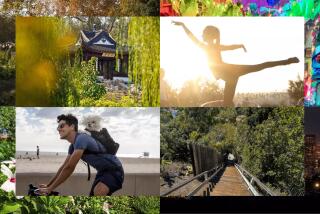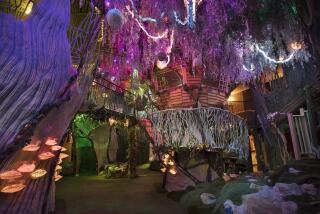Taos is still hitched to ‘Easy Rider’ and Hopper
TAOS, N.M. — Never mind that the original Summer of Love was 42 years ago and almost 1,000 miles away: Taos is offering its own version this year.
The summer-long celebration marks the 40th anniversary of the iconic counterculture film “Easy Rider” -- some of which was shot here -- and the influx of hippies that added yet another spicy ingredient to Taos’ multicultural stew.
Scheduled events include a “hippie homecoming” parade, art shows, concerts, costume contests and lectures about Taos’ bohemian edge and “Los Hippies.” Country Joe McDonald will re-create his performance from 1969’s Woodstock festival at a June 6 concert.
The Taos Summer of Love kicked off Monday when actor and artist Dennis Hopper was made honorary mayor of the town of 5,000. Hopper is curator of an exhibition that opens today at the Harwood Museum of Art here.
“It was magical to me,” Hopper recalls of his first visit while scouting locations for “Easy Rider.” “I thought, if I ever make any money, I’m going to come back here.”
“Easy Rider” did make money, and Hopper bought the rambling old adobe house that had belonged to Mabel Dodge Luhan, the wealthy arts patron whose Taos salon drew D.H. Lawrence, Georgia O’Keeffe and others from the arts. It would be Hopper’s home for a dozen years.
Hopper, a self-described “compulsive creator,” is a longtime photographer, painter and collector who lives now in Venice, but he has maintained close ties to Taos.
When he was asked to curate “Hopper at the Harwood,” he reached out to five other contemporary artists who share slices of his past. Part of the hip, emerging contemporary art scene in Los Angeles in the 1950s and 1960s, they all eventually decamped to Taos, where they still live and work.
Larry Bell, Ron Cooper, Ronald Davis, Ken Price and Robert Dean Stockwell (actor Dean Stockwell) are “really world-class artists” whose work is rarely shown in Taos, Hopper says.
“They didn’t come looking for a style. . . . They were already well into contemporary art,” says Hopper, whose own photographs and paintings will be on view at the exhibition, which runs through Sept. 20.
Related events include a panel discussion on Aug. 1 led by critic Dave Hickey, who says in his essay for the exhibition’s catalog that in the 20th century, Taos “probably produced more serious art and literature than any other non-metropolitan area in the United States.”
“It’s been a place that arts have flourished in one form or another -- depending on what community you’re in -- for 800 years or 400 years or 100 years,” says photographer Gus Foster, who is on the governing board of the Harwood, part of the University of New Mexico.
Taos Pueblo was here for centuries before Spanish colonists began establishing farms and ranches nearby in the 1600s.
“It’s been a fertile place for creative people. Lots of writers, lots of musicians, lots of visual artists,” says Foster, who has lived and worked in Taos since 1976.
The historic Harwood -- with its thick adobe walls, high ceilings and traditional Southwestern ceiling beams and woodwork -- showcases artists who worked in the local, Hispanic traditions as well as the procession of Anglo artists who made their mark here.
The “founders,” painters largely from the East Coast, formed the Taos Society of Artists in the early part of the 20th century and are known for their landscapes, paintings of old-timers and idealized depictions of Indians.
The mid-century was marked by an influx of modernists -- the “Taos Moderns” -- that put the town on the map for contemporary art.
The artists represented by the “Hopper at the Harwood” exhibit “is like an unnamed next group . . . a yet-to-be named third generation,” says Jina Brenneman, the museum’s curator.
The show “really is all about Dennis’ profound respect for these artists,” she says.
Stockwell, an old friend of Hopper, first saw Taos in 1964. He had made “Sons and Lovers” in England and was captivated by Lawrence’s essays on Taos. When he saw the place, he says, “It was even more incredible than I thought . . . and I knew the minute I got here I was going to end up here.”
He visited annually and finally moved here about six years ago.
Stockwell lives on the outskirts of town, with sweeping views of the Sangre de Cristo Mountains that are Taos’ backdrop. The walls of his home are covered with original art -- his, and the late Wallace Berman’s, among others.
He began doing art seriously in 1956 after meeting Berman, an artist legendary in the Beat movement and Los Angeles art scene that developed the late ‘50s and ‘60s. Their friendship profoundly changed his life, Stockwell says. He didn’t make art with the intention of showing it, although he did the album cover for his friend Neil Young’s 1977 “American Stars ‘N Bars” album. It wasn’t until 2003 that he began making collages for exhibition and quickly began to have shows.
Besides the photo collages, he does “diceworks” -- sculptures made of dice.
Hopper started doing photography in 1961, and did his main body of black-and-white work over the next six years.
“I wanted to direct movies, so it seemed a natural thing to do,” he says. He stopped once he was into “Easy Rider” -- “working with [cinematographer] Laszlo Kovacs was exciting enough for me” -- and didn’t resume photography for another two decades.
More to Read
The biggest entertainment stories
Get our big stories about Hollywood, film, television, music, arts, culture and more right in your inbox as soon as they publish.
You may occasionally receive promotional content from the Los Angeles Times.










